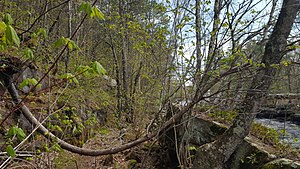
Back انتحاء أرضي Arabic Геотропизъм Bulgarian Gravitropizam BS Gravitropisme Catalan Gravitropismus Czech Geotropismus German Γεωτροπισμός Greek Gravitropismo Spanish Geotropism Estonian زمینگرایی Persian


Gravitropism (also known as geotropism) is a coordinated process of differential growth by a plant in response to gravity pulling on it. It also occurs in fungi. Gravity can be either "artificial gravity" or natural gravity. It is a general feature of all higher and many lower plants as well as other organisms. Charles Darwin was one of the first to scientifically document that roots show positive gravitropism and stems show negative gravitropism.[1] That is, roots grow in the direction of gravitational pull (i.e., downward) and stems grow in the opposite direction (i.e., upwards). This behavior can be easily demonstrated with any potted plant. When laid onto its side, the growing parts of the stem begin to display negative gravitropism, growing (biologists say, turning; see tropism) upwards. Herbaceous (non-woody) stems are capable of a degree of actual bending, but most of the redirected movement occurs as a consequence of root or stem growth outside. The mechanism is based on the Cholodny–Went model which was proposed in 1927, and has since been modified.[2] Although the model has been criticized and continues to be refined, it has largely stood the test of time.[citation needed]
- ^ Darwin, Charles; Darwin, Francisc (1881). The power of movement in plants. New York: D. Appleton and Company. Retrieved 24 April 2018.
- ^ Haga, Ken; Takano, Makoto; Neumann, Ralf; Iino, Moritoshi (January 1, 2005). "The Rice Coleoptile Phototropisim1 Gene Encoding an Ortholog of Arabidopsis NPH3 Is Required for Phototropism of Coleoptiles and Lateral Translocation of Auxin(W)". Plant Cell. 17 (1): 103–15. doi:10.1105/tpc.104.028357. PMC 544493. PMID 15598797.
© MMXXIII Rich X Search. We shall prevail. All rights reserved. Rich X Search